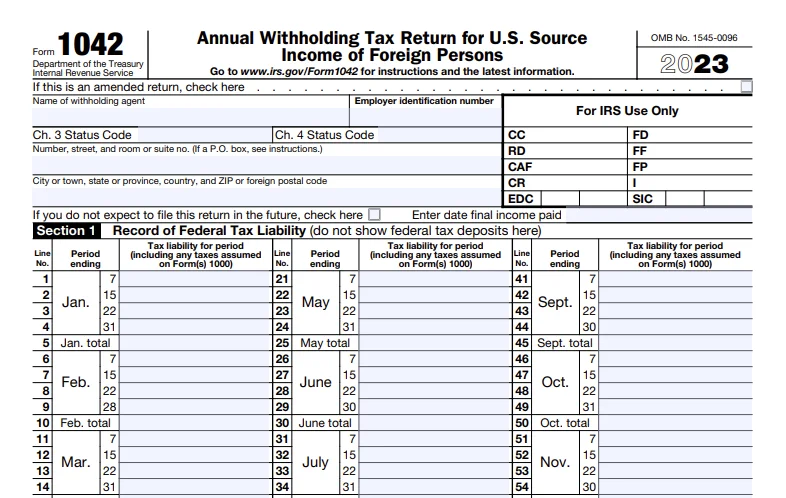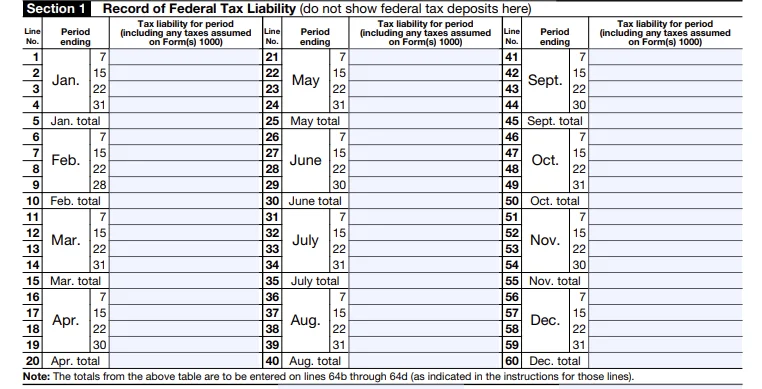Form 1042: An Overview
Updated on April 08, 2024 - 10:30 AM by Admin, TaxBandits
When a U.S. source of income is paid to individuals or entities outside the country, the payer is often required to withhold a percentage of that income for tax purposes. Form 1042 is used to report these withholdings to the Internal Revenue Service (IRS). It includes details about the payer, the recipient, the type and amount of income, and the amount withheld.
Table of Contents:
- What is Form 1042?
- What is Form 1042 used for?
- Who must file form 1042?
- What are the updates in Form 1042 for the 2023 Tax Year?
- What do chapter 3 or chapter 4 codes apply in Form 1042?
- What is Tax Liability and how to fill it in Section 1 of Form 1042?
- How do you e-sign your Form 1042?
- When is Form 1042 due?
- Can you get an Extension from filing your Form 1042?
- What is the penalty if you haven’t filed your 1042 return on time?
- How Do I File Form 1042 for 2023?
1. What is Form 1042?
Form 1042 is a U.S. tax form used for reporting tax withheld on certain income paid to foreign persons, including non-resident aliens, foreign corporations, and other foreign entities. The purpose of Form 1042 is to report withhold taxes on certain types of income that are subject to withholding under U.S. tax laws.

2. What is Form 1042 used for?
Form 1042 is an annual withholding tax return for U.S. source income of foreign persons. It’s used to report the tax withheld on certain income of foreign persons, including nonresident aliens, (foreign) partnerships, corporations, estates, and trusts. It’s also used to report the tax withheld under Chapter 4 on withholdable payments and the tax withheld under Section 5000C on specified federal procurement payments. In addition, it’s used to report payments that are reported on Form 1042-S under Chapters 3 or 4.
3. Who must file Form 1042?
Form 1042, Annual Withholding Tax Return for U.S. Source Income of Foreign Persons, is used to report tax withheld from certain income of foreign persons.
According to the IRS, every withholding agent or intermediary who receives, controls, has custody of, disposes of, or pays a withholdable payment or amount subject to withholding must file Form 1042 with the IRS. Form 1042 is solely filed with the IRS and isn't sent to payees.
Withholding Agent
A withholding agent is a U.S. or foreign individual who has control over a foreign person's withheld income. A withholding agent may be an individual, trust, estate, partnership, business, nominee, government agency, organization, or tax-exempt organization.
Intermediary
Someone who serves as a custodian, broker, or agent for another person, regardless of beneficial ownership. There are various types, including:
- Qualified Intermediary (QI)
- Withholding Foreign Partnership (WP)
- Withholding Foreign Trust (WT)
- Nonqualified Intermediary (NQI)
- Nonwithholding Foreign Partnership (NWP)
- Nonwithholding Foreign Trust (NWT)
- Qualified Derivatives Dealer (QDD)
- Qualified securities lender (QSL)
- Foreign financial institution (FFI)
- Registered deemed-compliant FFI (RDCFFI)
- Participating FFI (PFFI)
- Recalcitrant account holder
- Passive nonfinancial foreign entity (NFFE)
Each has specific roles and responsibilities outlined in these IRS regulations.
4. What are the updates in Form 1042 for the 2023 Tax Year?
The following updates have been made to Form 1042 for the 2023 tax year:
1. Electronic filing
Form 1042 now requires electronic filing. Withholding agents, notably financial institutions and those submitting ten or more information returns each year, as well as partnerships with more than 100 partners, must
file 1042 electronically with the IRS beginning in the 2023 tax year. However, in response to input from Withholding agents regarding concerns with the electronic filing of Form 1042, the IRS has announced that the e-filing requirement would be postponed.
According to IRS Notice 2024-26, US withholding agents are administratively exempt from the Form 1042 e-filing requirement in calendar year 2024. Foreign withholding agents will be administratively exempt in 2024 and 2025.
2. Section 1446(f) withholding
Beginning in tax year 2023, withholding agents acting as brokers for publicly traded partnership interest transactions must withhold tax under Internal Revenue Code Section 1446(f) and disclose this withholding on Form 1042 to the IRS.
3. Revised QI Agreement and QDD Reporting:
The qualified intermediary (QI) agreement in Revenue Procedure 2022-43 becomes effective on January 1, 2023, succeeding the QI agreement in Revenue Procedure 2017-15, which expired in December 2022. According to the QI agreement, every QI that was a "qualified derivatives dealer" (QDD) or had a QDD branch during the tax year is required to file Schedule Q (Form 1042) for the 2023 tax year.
5. What do chapter 3 or chapter 4 codes apply in Form 1042?
Withholding agents must enter both a Chapter 3 and a Chapter 4 withholding agent status code, regardless of the kind of payment made. Withholding agents should use the code that corresponds to your current status.
Chapter 3: About the Type of Income
Sections 1441-1443 govern Chapter 3 withholding, which typically entails applying a 30% withholding rate to payments of FDAP income or profits from US sources. This occurs only if the income or gains are not properly related to the United States.
Chapter 4 (FATCA): Rules for Reporting by FFIs
Chapter 4 withholding requires a withholding agent to withhold 30% of payments considered withholdable when paying an FFI unless the FFI qualifies as a participating FFI, deemed-compliant FFI, or exempt beneficial owner.
6. What is Tax Liability and how to fill it in Section 1 of Form 1042?
Record of Federal Tax Liability (Lines 1–60)
These lines show the tax you owe when the income was paid or collected for each quarter-monthly period, under Chapter 3 or 4. This is true regardless of whether the withholding agent handled the responsibility through withholding or paid it directly. Do not use negative numbers on these lines.
OnIf you are required to report a reduction in liability on line 59 (due to a repayment made under the reimbursement or set-off procedure), and this results in a negative amount of tax liability for the period corresponding to line 59, you should instead report any negative amount for the next earlier period(s), so that no negative amounts are reported on lines 1 through 60.

7. How do you E-Sign your Form 1042?
The IRS accepts a wide range of electronic signatures. An electronic signature is a way to get approval on electronic documents. You can e-sign your 1042 Form with the IRS through Form 8453-WH, E-file Declaration for Form 1042. This form is used to:
- Authorize an electronic Form 1042, Annual Withholding Tax Return for U.S. Source Income of Foreign Persons.
- If not filing using an Electronic Return Originator(ERO), allow the Intermediate Service Provider (ISP) to transmit the 1042 Form through a third-party transmitter.
- Provide consent to authorize the electronic funds withdrawal to pay the balance due on Form 1042.
8. When is Form 1042 due?
The Form 1042 filing deadline for the 2023 tax year is March 15, 2024. Failure to file Form 1042 by the deadline or to request an extension may result in penalties.

Note: If the deadline falls on a Saturday, Sunday, or legal holiday, it will be the next business day.
9. Can you get an Extension from filing your Form 1042?
Yes Absolutely! you can get additional time to file 1042 to the IRS, by requesting an extension for up to 6 months by filing Form 7004. Please note that this extension is granted for filing purposes only and does not affect the deadline for paying any taxes owed to the IRS.
10. What is the penalty if you haven’t filed your 1042 Form on time?
Form 1042 must be filed on time or face penalties. Form 1042 Penalties range from 5% to 25% of the unpaid tax for each month or partial month when the return is overdue. This penalty can accumulate over time, but it is limited to 25% of the unpaid tax. As a result, potential penalties increase with the length of the delay and possibly reaching a quarter of the unpaid tax amount.
11. How Do I File Form 1042 for 2023?
Form 1042 can be filed either on paper or electronically. Despite the recent delay in the e-filing requirement, the IRS still recommends using electronic filing for a more convenient and secure process.
TaxBandits, an IRS-authorized e-file provider, helps you E-File Form 1042 with the IRS and Get Instant Status updates regarding your Form 1042 return.
Complete your Form 1042 filing by following these simple steps:
-
Step 1: Create a Free account & Choose Form 1042
-
Step 2: Enter the Required Form 1042 Information
-
Step 3: E-Sign using Form 8453-WH
-
Step 4: Review and Transmit to the IRS

